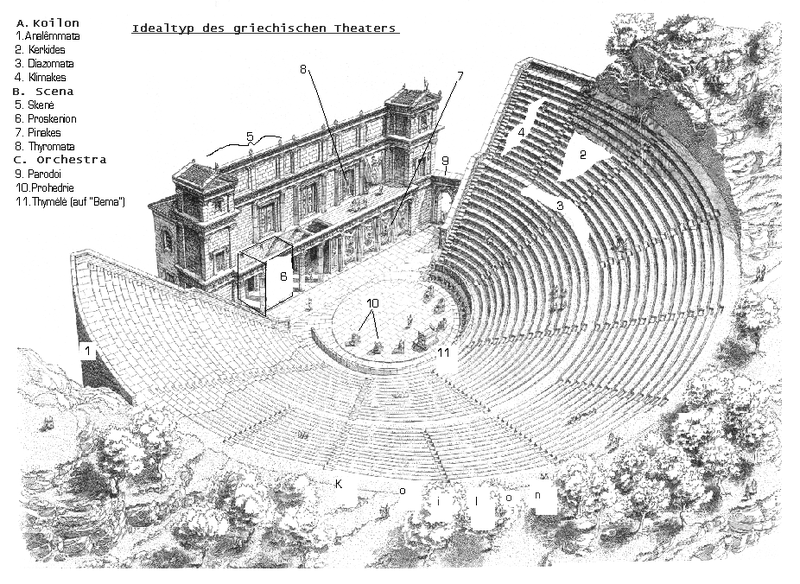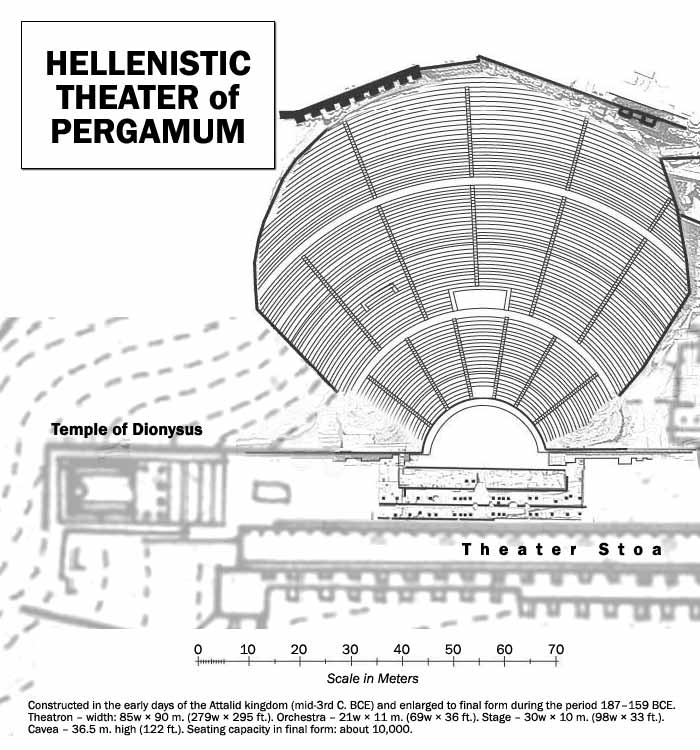The Lenaion or Lenaeum itself was a theatre construction and sanctuary in Athens as part of the Boulet. It is no longer extant. It was where the festival dramas of the Lenaea, both tragic and comic, were staged. The theatre itself was either outside the city or formed a section of the Agora in the centre of the City. Others say that the Lenaion as such never existed as a separate theatre building from the Dionysian Theatre.
The festival of the Lenaia is frequently depicted on vases, typically showing maenad scenes, Sometimes scenes of aristocrats and wine-mixing rituals are shown. It is unknown exactly which kind of religious rituals took place at the festival, but these may have been in honour of the young Dionysos or his rebirth following his murder by the Cyclopes. They may also have had some connection with the Eleusinian Mysteries, as several of the very same religious officials were involved (for example the archon basileus and the epimeletai or functionaries, who ‘take care of things’ such as organising the secret rituals that took place at Eleusis every year). These officials led the pompe (πομπή) or procession for the Lenaia, which also probably ended with a sacrifice and a feast of some kind.
At the Lenaia comedy had a more important place than tragedy. Several of Aristophanes' plays were first performed there. At the festival, five comedies were usually performed (reduced during the Peloponnesian War to three). There were no contests (agon) for the singing of dithyrambs. It is unknown when the Lenaia was abandoned, but the contests continued well into the 2nd century BC.
The Lenaion served a purpose on the second day of the Anthesteria [Choes-the Pitcher festival] a secret Symposium would take place here. The wife of the Archon Basilaeos, the Basilinna, would be married in a secret ceremony to the god Dionysos here on that day.
Macurdy, G. H. (1928). Basilinna and Basilissa, the Alleged Title of the “Queen-Archon” in Athens. The American Journal of Philology, 49(3), 276–282. https://doi.org/10.2307/290093 https://www.jstor.org/stable/290093
Peter Wilson (2003). The Athenian Institution of the Khoregia: The Chorus, the City and the Stage. The Lenaia: Cambridge University Press. pp. 27–. ISBN 978-0-521-54213-5.
Pausanias
Pausanias. Pausanias's Description of Greece. Cambridge University Press. pp. 27–. ISBN 978-1-108-04723-4.
Alberto Bernabé; Miguel Herrero de Jáuregui; Ana Isabel Jiménez San Cristóbal (26 June 2013). Redefining Dionysos. Redefining Dionysos from the written sources: The Lenaia ...: De Gruyter. pp. 100–. ISBN 978-3-11-030132-8.
Jeremy McInerney (2010). The Cattle of the Sun: Cows and Culture in the World of the Ancient Greeks. Princeton University Press. pp. 155–. ISBN 0-691-14007-3.
Christine Schnusenberg (2010). The Mythological Traditions of Liturgical Drama: The Eucharist as Theater. Paulist Press. pp. 152–. ISBN 978-0-8091-0544-1.
Lenaion
Walther Judeich
Rheinisches Museum für Philologie
Neue Folge, 47. Bd., (1892), pp. 53-60
Published by: J.D. Sauerländers Verlag
Article Stable URL:http://www.jstor.org/stable/41248299
NOTES ON ARISTOPHANES'S "FROGS"
W. B. STANFORD
Hermathena
No. 89 (May 1957), pp. 65-72
Published by: Trinity College Dublin
Article Stable URL:http://www.jstor.org/stable/23039700
ToposText - ἐν λίμναις - Limnai, site of important sanctuary of Dionysos
Limnai (Athens) 13 Athens Ilissos - Λίμναι, near Athens
Plutarch’s Religious Landscapes pp. 323 - Google Books
Peter Wilson (2003). The Athenian Institution of the Khoregia: The Chorus, the City and the Stage. The Lenaia: Cambridge University Press. pp. 27–. ISBN 978-0-521-54213-5.
The Attic Theatre: A Description of the Stage and Theatre of the Athenians
Karl Kerényi (1996). Dionysos. Princeton University Press. pp. 290–. ISBN 0-691-02915-6.
Karl Kerényi (1996). Dionysos. Princeton University Press. pp. 290–. ISBN 0-691-02915-6.
Pausanias
Pausanias. Pausanias's Description of Greece. Cambridge University Press. pp. 64–. ISBN 978-1-108-04723-4.
https://archive.org/stream/acropolisofathen00dooguoft#page/228/mode/2up
Primitive Athens as Described by Thucydides. CUP Archive. pp. 86–.
Primitive Athens as Described by Thucydides. CUP Archive. pp. 86–.
Alberto Bernabé; Miguel Herrero de Jáuregui; Ana Isabel Jiménez San Cristóbal (26 June 2013). Redefining Dionysos. Redefining Dionysos from the written sources: The Lenaia ...: De Gruyter. pp. 100–. ISBN 978-3-11-030132-8.
Jeremy McInerney (2010). The Cattle of the Sun: Cows and Culture in the World of the Ancient Greeks. Princeton University Press. pp. 155–. ISBN 0-691-14007-3.
Christine Schnusenberg (2010). The Mythological Traditions of Liturgical Drama: The Eucharist as Theater. Paulist Press. pp. 152–. ISBN 978-0-8091-0544-1.
Scott Scullion (1 January 1994). Three Studies in Athenian Dramaturgy. Walter de Gruyter. pp. 52–. ISBN 978-3-11-095053-3.
Sir Arthur Wallace Pickard-Cambridge; John Gould; David Malcolm Lewis (1969). The Dramatic Festivals of Athens: By the Late Sir Arthur Pickard-Cambridge. 2nd Ed. Revised by John Gould and D. M. Lewis. Oxford U. P.
Sir Arthur Wallace Pickard-Cambridge; John Gould; David Malcolm Lewis (1969). The Dramatic Festivals of Athens: By the Late Sir Arthur Pickard-Cambridge. 2nd Ed. Revised by John Gould and D. M. Lewis. Oxford U. P.
Jennifer Lynn Larson (2007). Ancient Greek Cults: A Guide. Psychology Press. pp. 134–. ISBN 978-0-415-32448-9.
Clifford Ashby. Classical Greek Theatre: New Views of an Old Subject. University of Iowa Press. pp. 37–. ISBN 978-1-58729-463-1.
Eric Csapo (1995). The Context of Ancient Drama. University of Michigan Press. pp. 121–. ISBN 0-472-08275-2.
Lenaion
R. E. Wycherley
Hesperia: The Journal of the American School of Classical Studies at Athens
Vol. 34, No. 1 (Jan. - Mar., 1965), pp. 72-76
Published by: The American School of Classical Studies at Athens
Article Stable URL:http://www.jstor.org/stable/147138
Lenaion
R. E. Wycherley
Hesperia: The Journal of the American School of Classical Studies at Athens
Vol. 34, No. 1 (Jan. - Mar., 1965), pp. 72-76
Published by: The American School of Classical Studies at Athens
Article Stable URL:http://www.jstor.org/stable/147138
Walther Judeich
Rheinisches Museum für Philologie
Neue Folge, 47. Bd., (1892), pp. 53-60
Published by: J.D. Sauerländers Verlag
Article Stable URL:http://www.jstor.org/stable/41248299
NOTES ON ARISTOPHANES'S "FROGS"
W. B. STANFORD
Hermathena
No. 89 (May 1957), pp. 65-72
Published by: Trinity College Dublin
Article Stable URL:http://www.jstor.org/stable/23039700
Brooklyn College/Classics 0.1/Dionysos at Athens
Lenaean | Online references | cyclopaedia.net
The Lênaia festival - Baring the Aegis blog
The Dramatic Festivals Of Athens: Pickard-Cambridge, Arthur - Internet Archive
Lenaia pp. 25-42
Redefining Dionysos - Internet Archive
The Lenaean Theatre
N. W. Slater
Zeitschrift für Papyrologie und Epigraphik
Bd. 66 (1986), pp. 255-264
Published by: Dr. Rudolf Habelt GmbH, Bonn (Germany)
Stable URL: http://www.jstor.org/stable/20186538
The Lenaea, the Anthesteria, and the Temple F5;̓ν Λίμναις
William Nickerson Bates
Transactions and Proceedings of the American Philological Association
Vol. 30 (1899), pp. 89-98
Published by: The Johns Hopkins University Press
DOI: 10.2307/282563
Stable URL: http://www.jstor.org/stable/282563
Simon Hornblower; Antony Spawforth; Esther Eidinow (29 March 2012), The Oxford Classical Dictionary, Lenaia: OUP Oxford, pp. 819–, ISBN 978-0-19-954556-8
Slater, N. W. “The Lenaean Theatre.” Zeitschrift Für Papyrologie Und Epigraphik, vol. 66, 1986, pp. 255–264. JSTOR, www.jstor.org/stable/20186538.
Boukoleion
Dionysos en Limnais
[Dionysos in the Marshes or Lakes]
Theory that the Lenaean Theatre
Lenaean | Online references | cyclopaedia.net
The Lênaia festival - Baring the Aegis blog
The Dramatic Festivals Of Athens: Pickard-Cambridge, Arthur - Internet Archive
Lenaia pp. 25-42
Redefining Dionysos - Internet Archive
The Lenaean Theatre
N. W. Slater
Zeitschrift für Papyrologie und Epigraphik
Bd. 66 (1986), pp. 255-264
Published by: Dr. Rudolf Habelt GmbH, Bonn (Germany)
Stable URL: http://www.jstor.org/stable/20186538
The Lenaea, the Anthesteria, and the Temple F5;̓ν Λίμναις
William Nickerson Bates
Transactions and Proceedings of the American Philological Association
Vol. 30 (1899), pp. 89-98
Published by: The Johns Hopkins University Press
DOI: 10.2307/282563
Stable URL: http://www.jstor.org/stable/282563
Simon Hornblower; Antony Spawforth; Esther Eidinow (29 March 2012), The Oxford Classical Dictionary, Lenaia: OUP Oxford, pp. 819–, ISBN 978-0-19-954556-8
Slater, N. W. “The Lenaean Theatre.” Zeitschrift Für Papyrologie Und Epigraphik, vol. 66, 1986, pp. 255–264. JSTOR, www.jstor.org/stable/20186538.
Boukoleion
Dionysos en Limnais
[Dionysos in the Marshes or Lakes]
Theory that the Lenaean Theatre
ToposText - ἐν λίμναις - Limnai, site of important sanctuary of Dionysos
Limnai (Athens) 13 Athens Ilissos - Λίμναι, near Athens
Plutarch’s Religious Landscapes pp. 323 - Google Books
The Play of Space: Spatial Transformation in Greek Tragedy - Rush Rehm - Google Books
Dionysus en Limnais by John Pickard
This paper discusses the literary and physical evidence for the Lenaeum (the sacred precinct of Dionysos in Athens), a site whose location was lost.
Dionysus en Limnais by John Pickard
This paper discusses the literary and physical evidence for the Lenaeum (the sacred precinct of Dionysos in Athens), a site whose location was lost.






